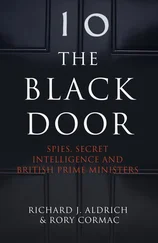However, disaster now struck. Four hundred miles north of the Arctic Circle the Cochino ran into a severe storm. Water poured in through a malfunctioning snorkel and a serious battery fire developed, burning for fourteen hours and producing large volumes of dangerous hydrogen. Some of the crew battled the fire using breathing equipment, but after a series of explosions they staggered back and admitted defeat. One crew member recalls: ‘They formed a grotesque aspect with their faces and hair burned. The skin was falling from their hands.’ 26 Commander Benitez and his seventy-eight crew decided to abandon ship just after midnight. Despite a rescue by the Tusk, seven men were lost to the stormy seas off the Norwegian coast. Six of these fatalities were brave rescuers from the Tusk who were equipped with faulty survival suits, while the seventh was civilian signals intelligence expert Robert W. Philo from the Cochino. Commander Benitez was the last man to make the treacherous crossing – effected by a swaying plank – between the two vessels. By the time the Tusk pulled clear the Cochino was already half-submerged. ‘With a final burst of spray she disappeared from sight,’ plunging into 950 feet of water. The Tusk took the casualties, many with severe burns, to Hammerfest in Norway, from where they were flown to London. 27 These were the first casualties in one of the most secretive and dangerous areas of Cold War signals intelligence activity. However, London and Washington were not deterred. By the early 1950s, British and American sigint submarines were regular visitors to the headquarters of the Soviet fleet. 28
Elint flights over the open sea were also sensitive and risky. On 8 April 1950 a US Navy elint aircraft, a PBY-42 Privateer, launched from Bremerhaven in northern Germany, was shot down while trying to identify new Soviet missile bases along the Baltic coast. The crew of four, who had named their aircraft the Turbulent Turtle, all perished. The Soviets later salvaged the Privateer’s elint equipment from the waters of the Baltic, and were in no doubt about the nature of the mission. Further missions were postponed. 29 Within a month of the shootdown of the Privateer, General Omar Bradley, then Chairman of the US Joint Chiefs of Staff, set out the case for resuming the flights, insisting that the intelligence they gathered was of the ‘utmost importance’. President Truman finally agreed to a resumption when told that US aircraft close to Soviet-controlled territory would be armed ‘and instructed to shoot in self-defense’. Truman minuted, ‘Good sense, it seems to me.’ The President’s green light was received on 6 June 1950, but after the outbreak of the Korean War later that month the flights were suspended for another few weeks due to ‘current hyper-tension and fear of further shoot-downs’. By the end of 1950, regular operations with RB-50Gs, ‘special mission’ elint aircraft adapted from an upgraded Superfortress bomber, were operating out of RAF Lakenheath airbase in East Anglia. 30
Norway was an early partner in all types of sigint operations. In 1952, Rear Admiral Anthony Buzzard, Britain’s Director of Naval Intelligence, paid a secretive visit to Norway. His requests were so sensitive that only handwritten notes were taken at the meetings. Buzzard asked for permission to launch special reconnaissance flights from Norway into Russian airspace using the RAF’s new Canberra aircraft, and also to run elint flights conducted within Norwegian airspace. However, the fate of the USS Cochino and then of the American Privateer had alerted the Norwegians to elint operations as a potential flashpoint, and they were cautious. Only permission for the latter flights within Norwegian airspace was granted. 31 By the mid-1950s the Norwegian Defence Intelligence Staff was beginning to experiment with the use of commercial trawlers as platforms for intelligence-gathering in the Barents Sea. Initially these were used for photographic reconnaissance, but they were gradually expanded to involve sigint monitoring. A ‘cover’ shipping company, Egerfangst, was established to run these operations, and its first vessel, the Eger, was in operation by 1956 using equipment supplied by the American NSA. 32
Although the most important sigint collected at short range came through perilous operations by air and sea, the British and Americans also boasted vast armies of land-based listeners crouching over their radio sets in wooden huts, often in inhospitable locations. Tactical sigint in peacetime presented a problem, since there was not much for Y service sigint to listen to. Yet on the first day of any future war with Russia – and war, if it came, was expected to come suddenly – the RAF would be required to reconstitute its vast legions of secret listeners. 33 In the event, the three services kept a large inter-service intercept formation in place, using personnel who were doing National Service. During peacetime they were lent to GCHQ, and spent much of their time collecting a wide range of signals, including diplomatic and commercial traffic. One RAF sigint officer observed, ‘Our only function is to receive the stuff in its cryptic form – a purely mechanical process – and pass it on to the body whose job it is to break it down.’ 34 By 1950 a system was in place whereby all those beginning National Service were asked if they would volunteer to learn Russian. The huge numbers of personnel who were trained up guaranteed a vast pool of tactical sigint operators who could be recalled on the eve of war, although GCHQ worried about how to hide the scale of the operation. This had profound consequences for the balance of power within post-war British sigint. It ensured that while the overall British sigint programme was coordinated by GCHQ, it was in fact provided by a complex alliance of GCHQ and the three armed services. This secret pact suited everyone – except for the Treasury, which struggled to track sigint spending, hidden as it was under a welter of misleading headings and cover organisations. 35
The outbreak of the Korean War on 25 June 1950 triggered a massive expansion of the riskier and more dangerous short-range operations to collect all types of sigint, including elint. Tensions were high, because the strategic planners believed that the outbreak of global war was not far away. Hitherto the Americans had been dependent on the British to cover much of north-west Europe, but now Americans began to arrive in numbers and their listening stations sprouted all over Britain, often disguised as RAF stations. In 1952 the 47th Radio Squadron of the US Air Force Security Service arrived at Kirknewton airbase in Scotland, from where it could monitor shipping off the Kola Peninsula. In October that year Squadron Leader J.R. Mitchell became the first dedicated ‘Liaison Officer for GCHQ’ on elint in Washington. 36
The accelerated pace of operations paid dividends. By 1952 elint experts in London and Washington had achieved a comprehensive picture of the Soviet Air Force. This had not required the breaking of Soviet codes. Instead, most of it was achieved through a mixture of elint or direction-finding, which simply meant using triangulation to locate specific Soviet units. GCHQ also listened in on clear voice traffic used by Soviet air-defence controllers giving instructions to fighters. There were large gaps in both Soviet air warning and coastal radar, which were mapped carefully. Anti-aircraft radar around Moscow was examined with special attention. Elint experts had been able to follow air-defence exercises in which the Soviets had used tiny strips of aluminium foil dropped from aircraft, known as ‘chaff’, as a radio countermeasure to fool radar operators into thinking large numbers of aircraft were airborne. Some of the more sophisticated Soviet work was thought to have been carried out by German experts captured by the Russians after 1945. Korea itself had proved to be a bonanza, with new Soviet radio equipment being captured, including direction-finding equipment which showed ‘marked improvement in design and construction’. 37
Читать дальше












